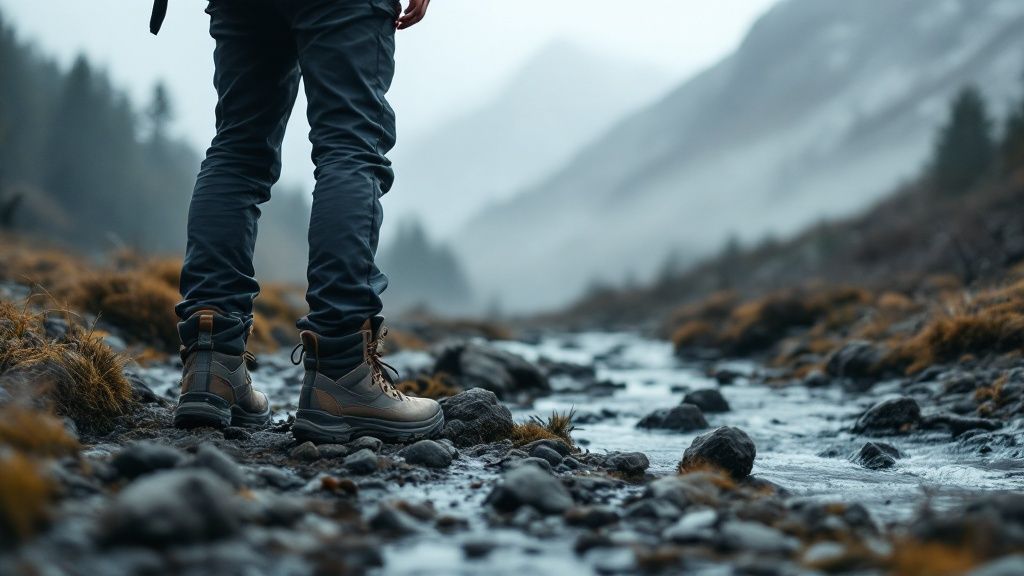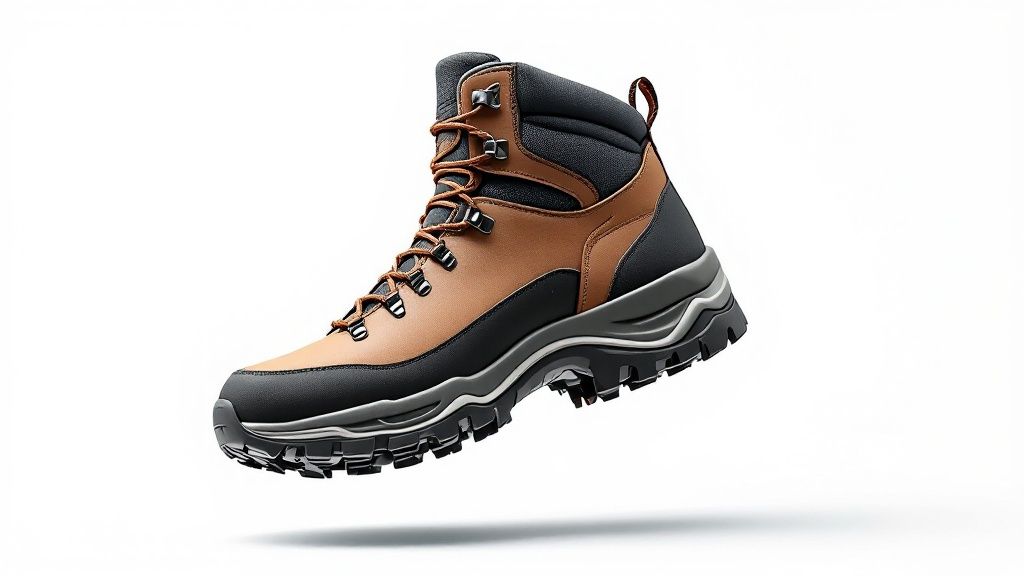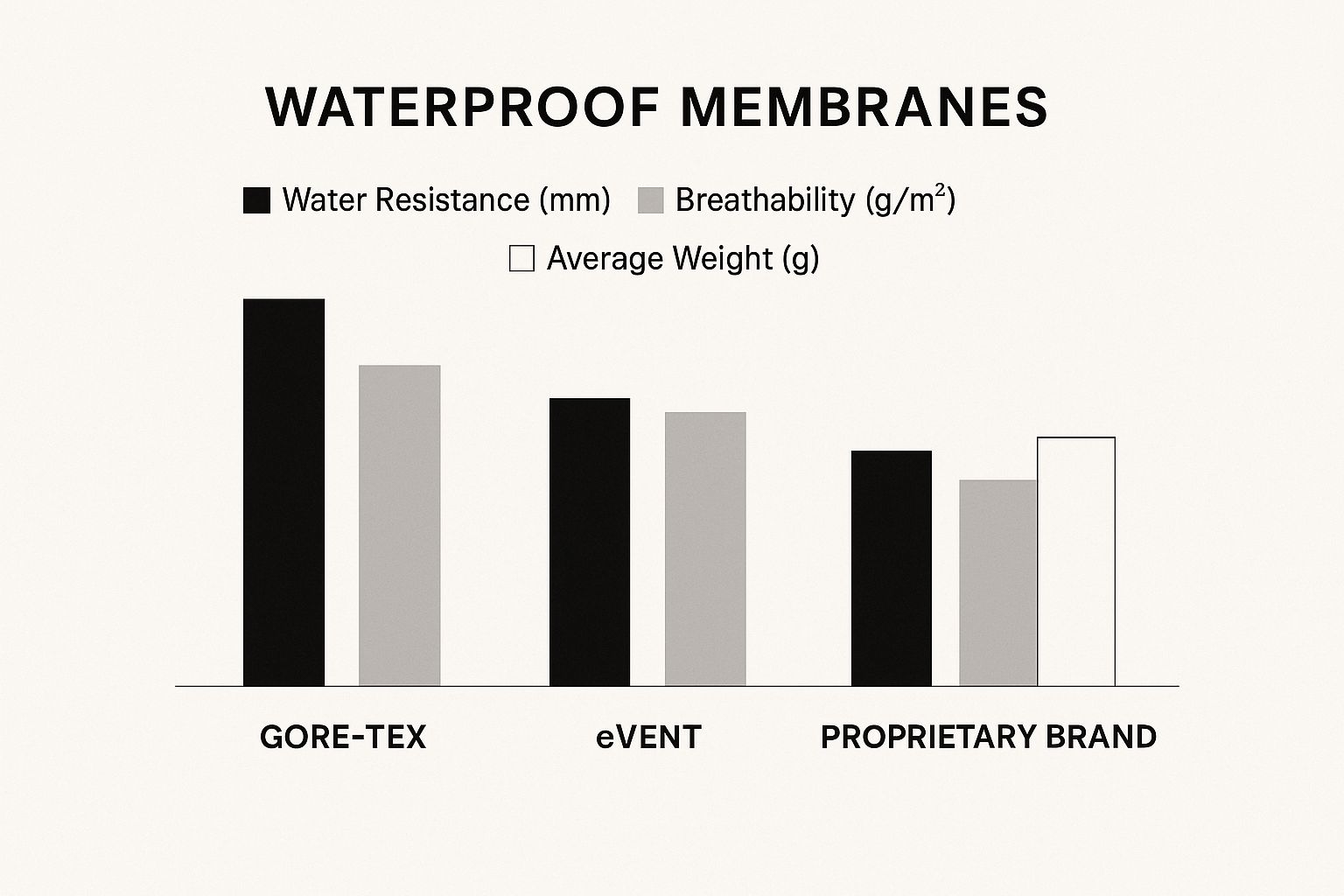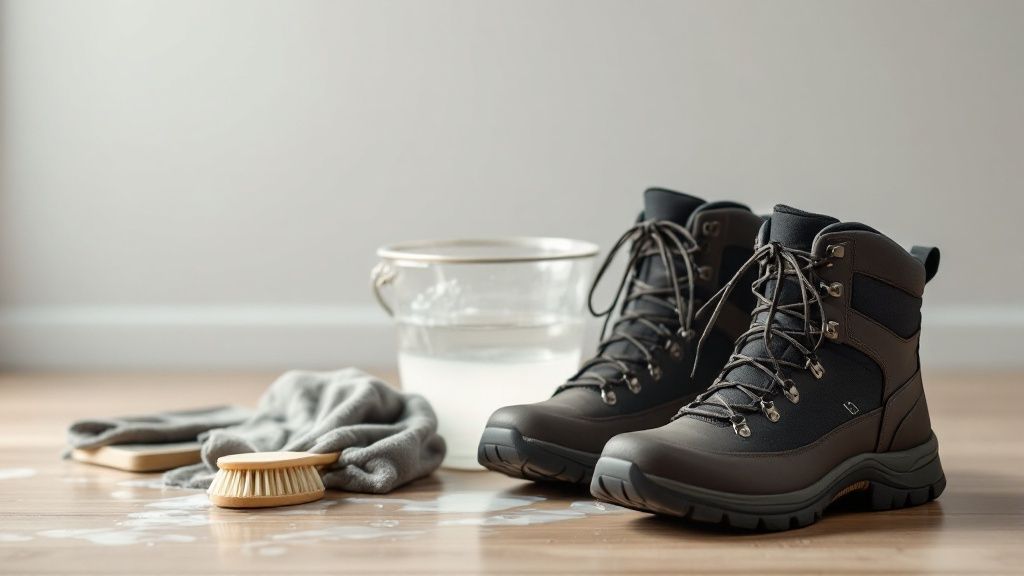When you're searching for the absolute best hiking boots waterproof technology can deliver, a few names always pop up for a good reason. We're talking about trail legends like the Salomon X Ultra 5 Mid GTX, the ever-reliable Merrell Moab 3 Mid Waterproof, and the powerhouse Lowa Renegade GTX Mid. These aren't just boots; they're your ticket to tackling just about any trail, in any weather.

Why Finding the Right Waterproof Hiking Boots Matters
Let's be honest, picking out waterproof hiking boots is one of the biggest gear decisions a hiker can make. It's the make-or-break choice that separates an incredible day on the mountain from a soggy, blister-filled nightmare. The market is absolutely flooded with options, and that can feel overwhelming. But knowing the key players and what they're truly built for makes all the difference.
It's a huge deal for a lot of people. The global market for waterproof hiking boots was valued at around $2.53 billion in 2025, a number that's set to climb by 5.4% each year through 2033. That tells you one thing: a whole lot of us are tired of wet feet. You can get a deeper look at the industry trends over at Datainsightsmarket.com.
What to Expect in This Guide
This guide is designed to cut through the marketing fluff. We're not just going to rattle off a list of features. We’re getting into the nitty-gritty of what makes a boot perform when you actually need it to. We'll help you figure out:
- Is GORE-TEX really the king in humid jungle treks, or is another membrane better?
- How does one boot’s outsole bite into slick, wet rock versus another’s performance in deep mud?
- Do you really need a heavy, tank-like boot, or would a lighter, nimbler model suit your adventures better?
Our mission is to give you the confidence to pick the right pair. Whether you’re scrolling through a giant online marketplace in Australia or trying on boots at your favorite local outfitter, you’ll know exactly what you’re looking for.
Before we dive deep, here's a quick rundown of our top picks to give you a lay of the land.
A Quick Glance at Our Top Waterproof Hiking Boot Picks
This summary table highlights our top-rated waterproof hiking boots and their ideal scenarios, helping you make a quick, informed decision.
| Boot Model | Best For | Key Differentiator | Price Tier |
|---|---|---|---|
| Salomon X Ultra 5 GTX | Day Hiking & Fastpacking | Sneaker-like agility with robust support | Mid-Range |
| Lowa Renegade GTX Mid | Backpacking & Rugged Terrain | Unmatched ankle stability and durability | Premium |
| Merrell Moab 3 WP | Beginner & Casual Hikers | Out-of-the-box comfort and versatility | Budget-Friendly |
| HOKA Kaha 3 GTX | Maximum Cushioning | Exceptional shock absorption for joint relief | Premium |
Think of this as your cheat sheet. Now, let’s get into the details and see how these trail warriors really stack up against each other.
What "Waterproof" Really Means for Your Hiking Boots
You see "waterproof" on the box and breathe a sigh of relief. Dry feet, here we come! But hold on—not all waterproofing is created equal. The real magic happens inside the boot, thanks to a high-tech membrane. Think of it as a microscopic bouncer at the club door of your boot.

This super-thin layer is riddled with billions of tiny pores. They're just big enough to let steamy sweat vapor out, but way too small to let big, clumsy water droplets in. It’s this one-two punch of waterproofing and breathability that separates a truly great boot from a sweaty rubber swamp.
Without that breathability, your feet would just be stewing in their own juices. And trust me, that's just as miserable as getting soaked by a rogue wave or a sudden downpour. Let’s dive into the main players fighting this microscopic war against water.
The Heavyweight Champion: GORE-TEX
When you think waterproof, you probably think GORE-TEX. It's the household name, the gold standard that every other technology gets measured against. For decades, its legendary reliability has made it the top choice for premier brands like Lowa and Salomon.
The secret sauce is its expanded polytetrafluoroethylene (ePTFE) membrane. It’s a mouthful, but all you need to know is that it provides a level of bulletproof, long-lasting water protection that you can absolutely bank on. Puddle misjudgment? All-day drizzle? GORE-TEX has your back.
But this ironclad defense can have a downside. In really hot, sticky weather, some hikers find GORE-TEX boots can feel a bit toasty. Your feet might be producing sweat faster than the membrane can vent it, leading to that dreaded clammy feeling.
The Bottom Line: GORE-TEX is your fortress. It's the go-to for wet, cold climates or gnarly trips where getting wet is simply not an option. It’s predictable, trusted, and it just works.
The Up-and-Comers: Proprietary Membranes
Not wanting to let GORE-TEX have all the fun, plenty of boot brands have cooked up their own in-house waterproof tech. You’ll see names like KEEN.DRY or Merrell's M-Select DRY (which is evolving in their latest models). The goal is the same: find that sweet spot between dry and breathable, but often at a friendlier price.
These proprietary membranes work on the same basic principle as their famous cousin, just with different materials and construction. Be warned, though—performance can be all over the map.
So, How Do They Stack Up on the Trail?
- Surprise River Crossing: A GORE-TEX boot like the Lowa Renegade GTX Mid is going to keep you bone dry, no questions asked. A boot with a brand's own membrane, like the Merrell Moab 3, will also put up a fantastic fight, though its armor might not hold up as long after years of hard-core abuse.
- Swampy Summer Hike: This is where breathability becomes the hero. Some proprietary membranes are specifically engineered for better airflow, which can give them an edge in steamy conditions. That said, GORE-TEX is fighting back with newer tech like its Invisible Fit, found in boots like the HOKA Kaha 2 GTX. It’s lighter, more flexible, and a huge step up for warm-weather comfort.
Ultimately, the choice comes down to your wallet and your wilderness. GORE-TEX is the premium, guaranteed-dry option. A good proprietary membrane can offer amazing value and, in some cases, a more comfortable ride in the heat. It’s all about matching the tech to the trail.
The Great Grip Debate: Who Keeps You on Your Feet?
Let's be honest for a second. The most advanced waterproof tech in the world is completely useless if you're sliding down the trail on your backside. A dry foot doesn't mean much when you're staring up at the sky, wondering what just happened. This is where we get to the real soul of the boot—the gritty, grippy world of traction and outsole performance.
It's the part of the boot we think about the least, but it’s arguably the most critical for your safety. Boot makers are in a constant arms race to create the perfect rubber compound, one that sticks like a gecko to wet rock but doesn't shred to pieces after a few tough hikes. This is where the legends of the industry separate themselves, turning a simple slab of rubber into a high-performance gripping machine.
Vibram vs. Contagrip: The Titans of Traction
Flip over almost any high-end hiking boot, and you'll likely see one of two names staring back at you: Vibram or Salomon's own Contagrip. This is the shoe-nerd equivalent of a superhero showdown. Each brand has its die-hard fans and a totally different philosophy on how to keep you stuck to the ground.
Vibram Megagrip: The Gold Standard for Stickiness
Vibram is the undisputed champ of the outsole game. That iconic yellow octagon is more than a logo; it's a seal of approval, a sign that you're getting uncompromising quality. Their Vibram Megagrip compound is legendary for a reason—it strikes a phenomenal balance between pure stickiness and long-haul durability. It feels almost tacky to the touch, giving it an uncanny ability to latch onto smooth, sketchy surfaces like wet granite or moss-covered logs.
- When It Shines: If you're hiking in the mountains where you'll encounter a ton of exposed, slick rock, Megagrip is a true lifesaver. The Danner Mountain 600 uses it to create a feeling of fortress-like security, whether you're on gritty sandstone or navigating a muddy slope.
Salomon Contagrip: The All-Terrain Specialist
Salomon plays the game a bit differently. Instead of a single "super-compound," their All-Terrain Contagrip is a complete system. They meticulously blend different rubber densities and lug shapes to create an outsole that just works, no matter what you throw at it. The aggressive, chevron-shaped lugs you’ll find on boots like the Salomon X Ultra 5 are engineered to bite deep on the way up and act like a powerful brake on the way down.
- When It Shines: Your typical hike involves a bit of everything—packed dirt, sloppy mud, rocky scrambles, and forest floor. This is where Contagrip's versatility is impossible to beat. It’s the jack-of-all-trades that almost never feels out of its element.
The Bottom Line: Go with Vibram Megagrip for its specialized, almost leech-like grip on wet, hard surfaces. Choose Salomon Contagrip when your adventures demand a reliable, do-it-all performer that can handle a mixed bag of terrain.
Lugs, Mud, and the Art of Staying Upright
It's not just about the rubber. The actual design of the lugs—those chunky treads on the bottom of your boot—plays a huge part in how you connect with the trail. Their depth, shape, and spacing are all part of a complex puzzle that boot designers obsess over.
Deep, widely spaced lugs are brilliant for shedding mud and digging into soft ground, preventing your outsole from turning into a useless, caked-up brick. On the flip side, a pattern with more surface area and shallower lugs gives you better contact for gripping hard, flat rock. It's a tricky balancing act.
The sheer money poured into this tech tells you how important it is. Hiking footwear is a colossal $19.7 billion global industry. The waterproof segment we're digging into here is a massive $1.2 billion niche all by itself. Companies invest a fortune in outsole R&D because they know one simple truth: grip sells. If you want to dive deeper, you can explore more hiking footwear statistics and see the full picture.
In the end, this great grip debate doesn't have a single winner. The best hiking boots waterproof soles can offer are the ones that are perfectly matched to where you hike. Thinking hard about the terrain you tackle most often is the secret to choosing an outsole that will keep you safe, confident, and firmly on your own two feet.
Head-to-Head: A Waterproof Hiking Boot Showdown
Alright, let's get to the main event. We've talked tech and tread, but now it's time to see how these trail titans actually stack up against each other. It's one thing to read a spec sheet, but it's another to know how a boot feels on mile ten with a storm rolling in.
We’re putting three legends in the ring. In one corner, you've got the Salomon X Ultra 4 Mid GTX, the go-to for hikers who like to move fast and light. In the other, the ridiculously popular Merrell Moab 3 Mid Waterproof, the undisputed king of comfort right out of the box. And holding down the heavyweight spot is the Lowa Renegade GTX Mid, a backpacking beast built to haul serious weight over serious terrain.
This isn't just a feature list. We're getting into the nitty-gritty of how they feel, how they hold up, and who should buy which one. Let's dig in.
The Support Spectrum: Agility vs. Stability
The first real battleground is support. This is where you separate the day-trippers from the serious backpacking boots, and each of these three has a totally different philosophy.
The Salomon X Ultra 4 Mid GTX feels more like a souped-up trail runner than a clunky boot. Salomon uses what they call an ADV-C Chassis—basically a molded plastic insert that gives you a surprising amount of side-to-side stiffness without killing flexibility. It keeps your ankle from rolling on rocky trails but still lets you feel nimble.
On the complete opposite end of the spectrum is the Lowa Renegade GTX Mid. This thing is a fortress for your feet. Its support comes from a full-length stabilizer and a polyurethane “MONOWRAP” frame you can literally see cradling the foot. For backpackers carrying 30 pounds or more, this is non-negotiable. It’s the kind of locked-in security you crave when you're tired and navigating a sketchy patch of scree.
The Lowa Renegade provides fortress-like ankle support ideal for heavy packs, whereas the Salomon X Ultra 4 offers the agile feel of a trail runner. Choosing between them is about prioritizing burly protection over nimble speed.
The Merrell Moab 3 Mid Waterproof plants its flag right in the middle. It has enough ankle support for most day hikes and weekend trips with a moderate pack, but it doesn't have the aggressive chassis of the Salomon or the rigid frame of the Lowa. It’s all about approachable, all-day comfort for the masses.
Weight and Cushion: The Battle of Ounces
Every ounce counts, especially when you’re lifting your feet thousands of times a day. Here, the trade-off is crystal clear: the more protection and durability you get, the more weight you carry.
Let’s break it down by the numbers:
- Salomon X Ultra 4 Mid GTX: This is the lightweight champ, coming in at just 1 lb 14 oz for the pair. The synthetic materials and EVA foam midsole are all about keeping you fast and athletic on your feet.
- Merrell Moab 3 Mid Waterproof: Hitting the scales at around 2 lbs 2 oz, the Moab finds a nice balance. That little bit of extra weight buys you more cushioning, which is a big part of why it feels so good from the first step.
- Lowa Renegade GTX Mid: The Renegade is the heavyweight contender at roughly 2 lbs 7 oz. That weight comes from a tough nubuck leather upper and a polyurethane (PU) midsole, which is far more durable than the EVA foam used in the other two.
That last point is huge. While the Renegade is heavier, its PU midsole won't compress and pack out over time like EVA. After 500 miles, the Lowa will still feel supportive, while the Salomon and Merrell will have lost a lot of their initial cushion.
Waterproofing and Breathability Showdown
All three boots promise dry feet, but how they get there—and how much your feet can breathe—is a different story. It really comes down to the waterproof membrane inside.
This chart gives you a great visual on the trade-offs you make with different waterproofing technologies.

As you can see, keeping water out is one thing, but letting sweat escape is another. This directly impacts your comfort, especially on hot, humid days.
Both the Salomon and Lowa use a GORE-TEX membrane, which is still the gold standard for blending waterproofing with decent breathability. Merrell uses its own M Select DRY membrane. In the real world, GORE-TEX does have a slight edge in breathability, which you'll notice on sweaty, high-effort climbs. That said, Merrell's waterproofing is rock-solid for the price, making it a fantastic value.
Waterproof Hiking Boot Feature Comparison
To make it even easier to see the differences, I've put the key specs side-by-side. This table cuts through the marketing and gets straight to what matters for you on the trail.
| Boot Model | Waterproofing Tech | Outsole Compound | Weight (Pair) | Ankle Stability | Ideal Use Case |
|---|---|---|---|---|---|
| Salomon X Ultra 4 Mid GTX | GORE-TEX | Contagrip® MA | ~1 lb 14 oz | Moderate/Agile | Fast-paced day hiking, light backpacking |
| Merrell Moab 3 Mid WP | M-Select™ DRY | Vibram® TC5+ | ~2 lbs 2 oz | Moderate | Day hiking, weekend trips, beginner-friendly |
| Lowa Renegade GTX Mid | GORE-TEX | Vibram® Evo | ~2 lbs 7 oz | High/Rigid | Multi-day backpacking with heavy packs |
At the end of the day, there's no single "best" boot here—only the best boot for the job. The nimble Salomon is for the fast-packer, the comfy Merrell is for the weekend warrior, and the unyielding Lowa is for the serious backpacker who needs a tool, not a toy. Choose the one that matches your adventure.
Matching the Right Boot to Your Hiking Style

Okay, we've just thrown a ton of tech specs and trail jargon your way. But let's be real—the secret to finding the perfect waterproof hiking boot isn't about some mythical "best boot" on the market. It's about finding the best boot for you.
The burly boots a thru-hiker needs to survive a 40-pound pack would feel like concrete blocks on a quick three-mile loop. The key is to be brutally honest about what you actually do out there.
For the Weekend Warrior on Maintained Trails
Is your happy place a five-to-ten-mile hike on a Saturday, cruising along well-marked paths? If so, you're not looking for a tank on your feet. You need something that feels more like a souped-up sneaker.
Comfort and agility are your game.
- Look For: Lightweight feel, cushy midsoles, and enough flex to feel natural.
- Steer Clear Of: Super-stiff, heavy boots built for mountaineering. They'll just drain your energy and feel clunky.
- Your Perfect Match: The Merrell Moab 3 is practically your soulmate. It gives you all the waterproofing you need for a surprise shower or a few puddles, but its main mission is comfort right out of the box.
Staying dry doesn't stop at your feet. To really weather-proof your adventures, check out our guide to the best waterproof jackets for hiking and build a complete system.
This kind of boot is the sweet spot for most hikers, giving you just enough protection without making you feel like you're lugging around extra weight.
For the Ambitious Day Hiker Tackling Tough Terrain
So your day hikes are a little spicier. You're chasing elevation, scrambling over rocky sections, and generally moving with a purpose. Your footwear needs to keep pace with that ambition.
You're in the market for a hybrid—something that has the athletic heart of a trail runner but the protective bones of a serious hiking boot.
- Look For: A solid chassis for support, aggressive lugs for traction on sketchy ground, and a fit that locks your foot in place.
- Your Perfect Match: This is where the Salomon X Ultra 5 GTX really comes alive. It's nimble enough to let you move fast, but its advanced chassis and sticky Contagrip outsole give you the confidence you need when the trail gets technical.
This is the boot for someone who needs unwavering performance on steep descents and slick rock, pushing their limits from sunrise to sunset.
For the Long-Distance Backpacker
When you're living out of a backpack for days on end, your boots are no longer just footwear. They become critical pieces of support equipment. The weight of your pack amplifies every single step, and your feet and ankles are on the front line.
Lightweight and cushy? Forget about it. Your new priorities are uncompromising stability and durability.
Maximum ankle support is a must to prevent a trip-ending twist, and you need a tough midsole that won't pack out and turn to mush under a heavy load.
- Look For: A high-cut design for ankle protection, a stiff sole that provides a solid platform, and bombproof materials like leather.
- Your Perfect Match: Welcome to the world of the Lowa Renegade GTX Mid. This boot is an absolute workhorse, built from the ground up to support hikers carrying serious weight over unpredictable terrain. The level of support it offers is in a completely different universe.
Got Questions About Waterproof Hiking Boots? We've Got Answers
Stepping into the world of waterproof hiking boots can feel a bit like staring at a trail map with a dozen forks in the road. Which way do you go? Don't sweat it. We've heard all the questions from hikers just like you, and we're here to give you the straight-up, practical answers you need.
Think of this as your personal Q&A with a trail-worn expert. We'll cover everything from scorching summer treks to the down-and-dirty details of keeping your boots in fighting shape. Getting this stuff right is the difference between a day of happy miles and a day of miserable blisters. Let's get into it.
What’s the Real Difference Between Waterproof and Water-Resistant?
This is a big one. Getting this wrong can absolutely ruin your day, so listen up. The difference between these two terms is massive and comes down to how much protection you can actually count on when the sky opens up.
A water-resistant boot has a coating on the outside that makes water bead up and roll off. It's fine for brushing against dewy grass or getting caught in a light five-minute drizzle. But that coating wears off, and it will completely surrender to steady rain or an accidental step in a puddle.
A waterproof boot is a whole different beast. It has a built-in, seam-sealed membrane (think of a GORE-TEX sock stitched inside the boot) that creates a solid barrier. This is the tech that lets you stand in a shallow creek, plow through slushy snow, or hike for hours in a downpour and still have bone-dry socks. For any serious hiking, "waterproof" is what you're looking for.
Aren't Waterproof Hiking Boots Too Hot for Summer?
It’s a totally fair question—nobody wants their feet cooking inside their boots. While it's true a fully waterproof boot won't feel as breezy as a mesh trail runner, modern boot technology has come a long, long way.
The magic word here is breathability. The high-tech membranes in the best waterproof boots are packed with billions of microscopic pores. These tiny holes are small enough to block big water droplets from getting in but just large enough to let your sweat vapor escape.
So, are they too hot? It all depends on where you're hiking.
- Hot, Dry Desert Hike: Honestly, yes. In a place with zero chance of rain, you'd be much happier in a more breathable, non-waterproof shoe.
- Mountain Hike with Afternoon Storms: For high-altitude trails where a surprise thunderstorm is practically a daily event, the peace of mind from a waterproof boot is priceless.
- Humid Forest Trail with Creek Crossings: Here, waterproof boots are your best friend for staying dry. The key is to pair them with top-notch moisture-wicking wool or synthetic socks to manage the sweat.
The bottom line? For most three-season hiking, a modern waterproof boot hits that sweet spot between protection and comfort. It's the go-to choice for unpredictable weather.
How Long Does the Waterproofing on Hiking Boots Actually Last?
This is a two-part answer. You've got the internal membrane and the external coating.
The internal waterproof membrane—the real engine of the boot's waterproofing—is incredibly tough. As long as you don't poke a hole in it, it should last for the entire functional life of the boot. It’s pretty set-and-forget.
The part that needs your attention is the Durable Water Repellent (DWR) coating on the outside. This is the finish that makes water bead up so beautifully. Over time, dirt, dust, and scuffs from rocks and branches will wear it down.
You'll know it's time for a refresh when the boot's outer fabric starts soaking up water and looks dark and soggy. This is called "wetting out." Your feet might still be dry because of the inner membrane, but a soaked boot gets heavy and loses almost all its breathability. A good cleaning and a fresh coat of DWR spray every few months of hard use will keep them performing like new.
How Do I Take Care of My Waterproof Hiking Boots?
Taking good care of your boots is the secret to making your investment last. Tossing them in the corner caked in mud is the fastest way to ruin them. The good news? Maintenance is easy.
Your Post-Hike Boot Care Routine
- Clean 'Em Up: After every hike, knock off the big chunks of mud. Use a medium-stiff brush and some lukewarm water to scrub off the rest of the grime.
- Pull Out the Insides: Remove the insoles and laces. This helps the inside of the boot dry out completely and you can wash the insoles if they're getting funky.
- Let Them Air Dry: This is crucial. Never put your boots near a campfire, radiator, or use a hairdryer on them. Intense heat can destroy the leather, melt the glues, and wreck the waterproof membrane. Stuff them with newspaper and let them dry slowly in a spot with good airflow, away from direct sunlight.
- Re-Treat When Needed: Once they're clean and dry, splash a little water on them. If it doesn't bead up, it's time to reapply a DWR spray. For leather boots, you'll also want to use a conditioner now and then to keep the leather from drying out and cracking.
Proper care keeps the waterproofing intact and helps the boot hold its shape, meaning more comfortable miles for you. And if you're planning multi-day trips where every piece of gear counts, our lightweight backpacking gear list has some great tips for keeping your pack light and efficient.
Knowing the answers to these questions puts you in the driver's seat. You're now ready to pick the perfect pair of waterproof hiking boots and hit the trail with total confidence.
Ready to gear up for your next adventure? Explore the fantastic selection of outdoor and travel essentials at AMI Cart. Find everything you need, from top-tier footwear to the latest gadgets, all with fast and free shipping across Australia. Your perfect trail companion is just a click away. Shop Now at AMI Cart




